Ijraset Journal For Research in Applied Science and Engineering Technology
- Home / Ijraset
- On This Page
- Introduction
- Conclusion
- Copyright
A Study on Consumer Satisfaction towards Samsung Mobiles
Authors: Rinaf Mohammed
DOI Link: https://doi.org/10.22214/ijraset.2023.52228
Certificate: View Certificate
Abstract
Introduction
I. INTRODUCTION AND DESIGN OF THE STUDY
A. Introduction
Smart phone is a term for distinguishing mobile phones with advanced features from basic feature phones. Early smart phones typically combined the features of a mobile phone with those of another popular consumer device, such as a Personal Digital Assistant (PDA), a media player, a digital camera, and GPS navigation unit. Modern smart phones include all of those features plus the features of a laptop, including web browsing, Wi-Fi, and 3rd-party apps and accessories. Customer satisfaction is a term frequently used in marketing. It is a measure of how products and services supplied by a company meet or surpass customer expectation. Customer satisfaction is defined as “the number of customers, or percentage of total customers, whose reported experience with a firm, its products, or its services (ratings) exceeds specified satisfaction goals.” Consumer behaviour encompasses a broad range of activities, including the selection, acquisition, use, evaluation, and eventual rejection of goods and services that consumers feel will suit their needs. We can all see that we are special in our own ways. The fact that we are, first and foremost, consumers is a unifying factor that transcends our many other distinctions.
The things we use or eat consistently incorporate food, garments, lodging, transportation, instruction, hardware, get-a-ways, needs, delights, administrations, and even thoughts. In the grand scheme of things, customers like us are essential to the success of economies everywhere. The demand for basic raw materials, transportation, manufacturing, and banking is affected by the choices we make as consumers; this, in turn, affects the number of jobs created and the amount of resources committed to various sectors. Particularly in the present serious and quickly advancing business sector, advertisers need to have a deep understanding of their target demographic. What they desire, what they believe, and how they use their leisure time are all examples. One who shops for themselves, their family, or as a friend is known as a "personal consumer." Products are bought by those who will utilise them in their final form; these people are known as end users or ultimate consumers. Understanding what drives customers to buy a product or service is crucial for marketers in making decisions about product development, market expansion, and product placement.
Customer lead is described as "the approach to acting that purchasers show in searching for, purchasing, using, evaluating, and disposing of things and organizations that they expect will satisfy their necessities". Consumer Attitude and Personality Marketers have tried to win over clients by playing to their individual attributes for as long as there have been marketers. They have long held the suspicion that individual differences in personality factors affect consumer spending habits and patterns of use. Therefore, advertisers and marketers have often employed depictions of people exhibiting certain personality characteristics or features in their products and services.
- An individual's unique characteristics are reflected in their personality.
- It has a solid foundation and will survive a long time.
It's also possible for things to shift. As Napoleon once stated, "Nothing is more precious than the power to choose," and this maxim could not be truer when discussing customers. Because of this, it's crucial for marketers to have a firm grasp on how customers make purchases. What follows are some of the aspects that have a role in shaping consumers' final buying decisions:
a. Personality
b. Socio-economic backgrounds
c. Culture Subculture
d. Socio-economic backgrounds
e. Mobility
f. Geographical Location
g Stages of the Life Cycle
Samsung has been one of the largest manufacturers in the world. They have captured the entire market in a short time. Samsung mobiles are now marketing in several Asian and European countries. The innovative features and build quality made Samsung a favourite of millions. In the year 2011, Samsung was the largest vendor of smartphones in India. These phones come in all ranges and provide good services. It has not only captured the market but made a special place in the hearts of many users. Other mobile brands could not afford to ignore this vast and potential total addressable market and are giving tough competition to Samsung. So this stud shows the customer satisfaction towards Samsung mobile Products.
B. Statement Of The Problem
The important part of a research is problem identification. Here the researcher identifies the problem as the customer preference on Samsung smart phone. In traditional era a consumer's primary usage for a mobile phone is for making and receiving personal calls. It's because the mobile industry follows the pattern of other technology-driven markets in which products are created before the needs of the market are fully understood. In order to take use of the faster network speeds, people will need to upgrade to a newer generation of mobile devices, such as a SAMSUNG smartphone, which has access to the internet and other high-end features. Modern consumers are more savvy, discriminating, and knowledgeable than ever before. Ads and word of mouth both play a significant role in shaping people's decisions about which mobile phone service provider to sign up with. Consistent consumer input helps businesses better understand their clients' wants, requirements, and preferences. The main motive of the study entitles to know the customer satisfaction on the Samsung smart phone in Coimbatore city.
C. Objectives Of The Study
- To study the demographic background of the respondents
- To know the consumer satisfaction towards Samsung mobiles.
- To identify the factors determining the purchasing behaviour of people.
D. Scope Of The Study
In the present scenario, cellular phone companies have heavy competition in the mobile market. The study covers the buying behaviour of consumers and the features that make Samsung mobile different from others. From this study, the performance and problems of the customer can be analysed. The study helps to know the factors that influence the customer to buy the product. This study helps to know the necessary change in product features and customer feeling about the Samsung smart phone. The study will be useful for the future study to make necessary changes in price, designs, apps, and etc.
E. Methodology Of The Study
Research methodology is a way of explaining how a researcher intends to carry out their research. It's a logical, systematic plan to resolve a research problem. A methodology details a researcher's approach to the research to ensure reliable, valid results that address their aims and objectives. It encompasses what data they're going to collect and where from, as well as how it's being collected and analysed. The research design of the project is descriptive as it describes data and characteristics associated with the population using mobile phones. Descriptive research is used to obtain information concerning the current status of the phenomena to describe “what exists” with respect to variables in a given situation.
The Methodology of the study includes:
- Area of the study
- Source of data
- Sample size
- Statistical tools used
- Area Of The Study
The Researcher chooses the area of the study in Coimbatore City.
2. Sources Of Data
To accomplish the objectives of the study, both primary and secondary data’s were collected.
- Primary Data
Primary data is that data which is collected for the first time. It is original in nature in the shape of raw material for the purpose of collection of primary data a well-structured questionnaire was filled by the respondents. The questionnaire comprises of close ended as well as ended questions.
- Secondary Data
Secondary data is the data which is already collected by someone. They are secondary in nature and area in shape of finished product. Secondary data was collected so as to have accurate results. Required data was collected from various books, magazines, journals and internet.
3. Sampling Method & Sample Size
The sampling used for the study is convenient sampling. This sampling is selected by the researcher for the purpose of convenience to access. For the study, sample sizes of 153 respondents were selected.
a. Population Of The Study: The population in Coimbatore city is infinite in nature. So I took randomly 200 respondents but all the respondents are not given the proper data. Some questions are not filled by them and not taken for the analysis part of the study. So I can collect only 153 filled questionnaires.
b. Data Collection: Once the research finds the problem, then the research designs the report and next process is to collection of data from several resources. The data is the primary objective of the research to collect information from the respondents. Data must be useful to the research and observation needed to prepare analysis based up on hypothesis set by the researcher. After this process we can get some ideas for helpful to obtain the logical conclusion. Depending up on the sources utilized by the researcher the data collection can be varied up on their performance and action.
- Primary Data
This is the one type of data collected by the researcher directly from the respondents based up on the study. The dependent information of a respondents can be gathered together to attain conclusion and also helpful for the future reference. It also sends to be the first hand data collected by the researcher for the immediate purpose of the study. In this Study the researcher tries to collect the customer demographic as well as the independent factors of them from the Users of Samsung Mobiles in Coimbatore city.
- Secondary Data
The type of data already exists in records. They cannot be gathered to use for immediate purpose. It is the data related to the Samsung company record includes internal data found in the organisation.
- Articles
- Websites
- Books
4. Tools Used In This Study
a. Percentage Analysis: Percentage simply means "per hundred" and the symbol used to express percentage is %. One percentage (or 1%) is one hundredth of the total or whole and is therefore calculated by dividing the total or whole number by 100. To calculate the percentage difference between two numbers, the same basic calculations are used. This is used to know the frequency of respondents.
b. Weighted Average Method: The weighted average is the method of calculating the average, in which each of the quantities is assigned a weight. Different weights are assigned to each of the quantities, based on their level of importance. Weighted average is the summation of the product of the weights and quantities, divided by the summation of the weights. To find a weighted average, multiply each number by its weight, then add the results. If the weights don't add up to one, find the sum of all the variables multiplied by their weight, then divide by the sum of the weights.
F. Limitations Of The Study
- The survey was limited to Coimbatore region only, so it cannot be applicable to all the areas.
- Time is one of the major constraints. Due to limitation of time only few people were selected for the study. So the sample of the consumers was not enough to generalize the finding of the study.
- The main sources of the data for the study were primary data with the help of self- administrated question. Hence, the changes of unbiased information less.
- People were hesitant to disclose the true fact.
- The chance of biased response can’t be eliminated though all necessary steps were taken to avoid the same.
G. Chapter Scheme
- Chapter 1 - Deals with the Introduction and design of the study
- Chapter 2 - Deals with the Review of literature
- Chapter 3 – Deals with the Overview of the Study
- Chapter 4 – Deals with the Analysis and Interpretation of data
- Chapter 5- Deals with the Findings, Suggestions and Conclusion
II. REVIEW OF LITERATURE
A. Introduction
Customer Satisfaction is an attitude that is decided based on the experience obtained. Satisfaction is an assessment of the characteristics or privileges of a product or service, or the product itself that provides a level of consumer pleasure with regard to meeting consumer consumption needs.
B. Reviews
A literature review is a comprehensive summary of previous research on a topic. The literature review surveys scholarly articles, books, and other sources relevant to a particular area of research. The review should enumerate, describe, summarize, objectively evaluate and clarify this previous research. The reviews related to the customer satisfaction of usage of Samsung mobiles is as follows:
- Assaari and Karia (2000)1 in their paper titled, “Churn Management towards Customer Satisfaction; A Case of Cellular operations in Malaysia” have viewed that customer satisfaction and customer service have been critical factors of the cellular industry. Cellular service providers need to ensure about the technology that provides customer service best in the industry. It is stated that investment in people and in technology helps in providing best customer service for today and for the future. One common ground that most carriers and customers agree on is that good customer service can have a key impact on how a customer views firm?s services and company.
- Bepko (2000)2 in his article entitled, “Service Intangibility and Its Impact on Consumer Expectations of Service Quality” has pointed out that among the areas which need to be addressed in service quality research is the nature of consumer expectations across the range of intangibility. Previous research has compared consumers service quality expectations across services, but different groups of subjects have been evaluated for each different service. The problem of using different subjects for each service is that the subjects? demographic characteristics may be responsible for the significant differences in expectations of quality.
- Carsten Fink, AadityaMattoo and RandeepRathindran (2001)3 in their study titled, “Liberalizing Basic Telecommunications: The Asian Experience” have found that despite the move away from traditional public monopolies, most Asian governments are still unwilling to allow unrestricted entry, eliminate limits on private and foreign ownership, and establish strong independent regulators.
- David M. Szymanski and David H. Henard (2001)4 in their study entitled, “The New Marketing Developing Long-term Interactive Relationships” have said that the growing number of academic studies on customer satisfaction and the mixed findings they report complicate the efforts among managers.
- Lawrence and Feick (2001)5 in their article titled, "The Impact of Switching Costs on the Customer Satisfaction-loyalty Link: Mobile Phone Service in France” have analysed that moderating role of switching costs in the customer satisfaction-loyalty link and to identify customer segments and to retain them. Thus the purposes of this paper are to examine the moderating role of switching costs in the customer satisfaction loyalty link and to identify customer segments and then analyse the heterogeneity in the satisfaction-loyalty link among the different segments. An empirical example based on the mobile phone service market in France indicates support for the moderating role of switching costs. Managerial implications of the results are discussed.
- Lee and feich (2001)6 argue that customer satisfaction contributes positively to customer retention. He found that switching cost plays a vital role in explaining the link. Switching costs further linked with quality. The mobile company's focus on quality will increase customer satisfaction.
- Liu (2002)7 in a recent paper, analysed and found that the choice of the mobile phone is characterized by two distinct attitudes towards brands: attitudes towards the mobile phone brand and attitude towards the network. Customer's choice of mobile phone brand is mainly affected by new features more than size. This trend of choosing is definitely towards phones with better capacity larger screens.
- Mack and Sharpies (2009)8 showed that availability is the most crucial determinant of mobile choice. Other attributes, particularly features, aesthetics, and cost, have implications for mobile brand choice.
- Subramanyam and Venkateswarlu (2012)9 income, advertising, and education level in a family determine factors of owning a phone set. The study was conducted on factors influencing mobile phone buyers' buyer behaviour in India's Kadapa district. The researchers study the various type of marketing strategies play in the consumer buying process.
- Joel Billieux (2017)10 despite its clear advantage, cellular phone use has been associated with harmful or potentially disturbing behaviours; the mobile phone's problematic use is considered an inability to regulate one's mobile use.
- Mr. Bankapur Bangarappa and Dr. Shiralashetti A.S (2017)11 Customers preferred brand image, features, battery backup, and resale value with an expected price. Today, every company is facing tough competition in the world. Customer satisfaction is the most critical event in management, and companies are trying to identify the needs, wants, and demands of the customers.
- Dr. Dawar Sunny (2019)12 Samsung brand is considered the most preferred brand in the Rajasthan than Videocon. The results have shown that Samsung consumers appear to be brand loyal, willing to pay a premium price and have a great community sense than Videocon consumers. The data was collected using the consumer survey method.
- Malasi (2020)13, Kenyan college freshmen were surveyed about their mobile phone preferences and how those preferences were affected by various product features. According to the results, the preferences of undergraduate students for mobile phones change when the product features are altered. Colour schemes, clearly displayed brand names, a selection of mobile phone models, secure packaging, the user's level of safety consciousness, the phone's aesthetic, and its overall design were all taken into account.
- Rahmani Vahid Tajzadeh Namin Aidin (2020)14 found that consumers' decisions on which brands to purchase were affected by factors such as household income, exposure to advertising, and level of education. According to the results, there is a link between consumers' perceptions of brands, companies, and the products they choose to use (specifically, mobile phones). There was also no correlation between unmediated or mediated decision-making and product preference. For most people, having a family is what makes them want to get a cell phone.
- Subramanyam and Venkateswarlu (2020)15 investigated what variables influenced people to purchase mobile phones in India's Cuddappah district. To better understand the impact that marketing plays in consumers' decision-making, researchers analysed the many approaches used by the market to attract the attention and understanding of both current and future buyers.
- Saif (2020)16 examined the variables that influence Pakistani customers' choosing of a mobile phone. According to the findings, consumers place a high premium on cutting- edge technology, which not only functions as a driving factor when deciding to buy a new smartphone but also acts as a key differentiator between competing models.
- Pakola et al. (2021)17 made an effort to probe the motivations behind cellular phone purchases by consumers. Price and features were found to be the most influencing variables in the acquisition of another cell phone, while cost, sound quality, and suggestions from companions were viewed as the most critical in selecting a mobile service provider.
- Das (2021)18 used a survey approach to conduct empirical study on what variables influence the purchasing decisions of young customers in the coastal areas of Odisha, India, when it comes to mobile handsets. The survey found that among young customers, women, college graduates, students, and city dwellers all had a strong preference for handsets that combined a reputable brand name with sleek design, innovative value added capabilities, and a pleasant user experience.
- Androulidakis, G., & Kandus, G. (2022)19 found that consumers' security habits differ depending on the make of their mobile devices. A user's behaviour might vary across a number of dimensions depending on the mobile phone brand they're using. Therefore, there is a classification, unique to each brand, of places where people are obviously missing security mind. Such a classification may aid phone makers in making more secure mobile phones, ideally in a way that is invisible to the user.
- Robert C. Ford, Cherill P. Heaton and Stephen W. Brown (2022)20 in their article titled, “Delivering Excellent Service Lessons from the Best Firms” have stated that many companies see investments in complaint handling as means of increasing customer commitment and building customer loyalty. However, firms are not well informed, on how to deal successfully with service failures or the impact of complaint handling strategies.
C. Research Gap
From this above review state that Samsung actively listens to customers through various channels and make further analysis to make improvements. A user's behaviour might vary across a number of dimensions depending on the mobile phone brand they're using.
There is a reason behind unique to each brand. It attracted customers mostly in their feature and quality. The choice of the mobile phone is characterized by two distinct attitudes towards brands: attitudes towards the mobile phone brand and attitude towards the network. So this analysis is made to understand the consumer preference and satisfaction of Samsung mobiles in the Coimbatore region.
III. OVERVIEW OF THE STUDY
A. Introduction- Customer Satisfaction
Customer satisfaction is defined as a measurement that determines how happy customers are with a company’s products, services, and capabilities. Customer satisfaction information, including surveys and ratings, can help a company determine how to best improve or changes its products and services. An organization’s main focus must be to satisfy its customers. This applies to industrial firms, retail and wholesale businesses, government bodies, service companies, non-profit organizations, and every subgroup within an organization.
- Steps To Improve Customer Satisfaction
a. Understand your customers.
The most important strategy for ensuring customer satisfaction understands your customers. How can you satisfy your customers if you don’t know who they are? If you don’t know their needs and pain points, how can you create a product or service that helps them resolve their challenges? Understanding your customers begins with customer profiling, where you identify their purchasing behaviours, pain points, demographic information, and critical characteristics to get a better sense of who they are. With this information, you can provide superior customer service that is delightful and speaks to their exact needs.
b. Create a customer-centric culture.
A customer-centric culture means that every team and department works to foster a positive customer experience. When everyone does their job duties with the customer in mind, they are constantly solving for the customer and working to satisfy their desires and satisfy them. For customer support, this means that all of your support practices are centered around the customer and providing satisfying experiences, like:
- Offering customer loyalty programs that are based on actions customers commonly take with your business so they don’t have to take extra steps to meet loyalty tiers
- Creating help-desk articles that use clear and easy to understand language so the customer can understand instructions
- Acting on customer feedback when they directly tell you their level of satisfaction with your business and provide areas of opportunity for improvement and growth.
c. Lead with empathy, always.
Leading with empathy is a pillar of all service practices, especially customer satisfaction, as it helps you show customers that you’re on their side and working to help them succeed. Empathy is especially critical during tough customer interactions, as the way you show support when a customer is struggling or frustrated demonstrates your level of care for them. Jessica Garcia, Customer Success Manager, says “Empathy when a customer is frustrated or seeking assistance…if the situation escalates, I always remind myself that the people won’t remember what you said but they will remember how you made them feel.”
d. Always ask for feedback.
Ensuring customer satisfaction relies on asking customers for feedback. It's the only way you’ll know how they feel, and Chloe Christiansen, Customer Success Manager, champions this tip: “I really like giving customers the option to give feedback to better understand the experience they are having with me, other internal teams, or our actual product.”
e. Act on customer feedback.
What’s the feedback you receive worth if you don’t analyse it and use it to understand your successes and shortcomings? Just as important as it is to ask for feedback, it’s also critical to act on it when you receive it. When you learn more about your customers’ experiences, you can apply your findings to your operations to ensure you continue the measures that serve you well and improve the ones that leave customers unsatisfied.
f. Give your support teams everything they need to succeed.
A critical factor for ensuring customer satisfaction is providing your support teams and reps with all of the resources they need to satisfy your customers. When they have everything they need to help, and they have everything they need to show up for every single customer, regardless of their issue. This encompasses everything from comprehensive on-the-job training during on boarding, opportunities for further development, and performance feedback, as well as the everyday resources they need on the job, like access to a phone to answer calls or roadmaps for escalation protocols if a customer gets frustrated.
g. Respond to customer reviews.
Responding to customer feedback increases satisfaction because it shows customers that you listen to what they have to say about your business instead of simply seeing them as a name on a receipt. You take interest in their thoughts about your business, and you interact with them as well.
h. Respond quickly.
Customers are always looking for fast solutions, so ensuring your support teams always respond in a timely manner is crucial to satisfying that desire. Ensure that your teams focus on being efficient with their time, and one of the ways to do this is to use automation when necessary. These involve the major steps to improve the customer satisfaction.
2. Benefits Of Customer Satisfaction
Customer satisfaction is more than just a “nice to have.” Getting it right has specific, tangible benefits, including:
a. Customer Loyalty
When your customers are satisfied, they believe in the brand and become loyal. These loyal consumers give brands repeat business and form a major part of the revenue. Losing customers greatly affects your business revenue and customer churn numbers. Adobe’s report said loyal consumers spent 67% more than new ones via repeat orders, upsells, etc. Add to this the positive word of mouth to friends and family from your loyal customers, which really starts to add up. Prioritize customer success so that satisfied existing clients feel they can promote the brand to their loved ones for their great experiences.
b. Support Pillars
Satisfied customers are more likely to stand by in times of crisis; they care for the brand and want to see it thrive. This has been observed in many cases for big brands, such as McDonald’s when there are rumours of caterpillars in their foods. They trust the brand and understand any shortcomings or crises that may befall them.
c. Sales Revenue
Brands focussing on customer satisfaction actively have healthy sales revenue. They do not lose old customers and have a steady revenue stream from repeat business. Customer satisfaction and increased revenue are directly correlated. Satisfied consumers stay loyal to your brand, interact with it, buy often, and make recommendations to their colleagues, friends, and family. Run online customer surveys to note which areas negatively impact customer satisfaction and need improvement. This will help improve customer satisfaction and reduce customer churn.
d. Boost brand reputation and popularity for benefits of customer satisfaction
Customer satisfaction impacts brand reputation and popularity. See customer feedback and figure out which areas could be improved and improve satisfaction. Is it accounts or customer service? Don’t be afraid to ask your customers; honest feedback will help manage expectations and act accordingly. Famous brands have dedicated teams and initiatives for improving customer satisfaction, which helps them, achieve high sales figures.
e. Reduce marketing expenses
Satisfied customers are your biggest advocates. Their positive word-of-mouth lends your brand credibility and popularity and helps acquire new consumers. This saves brands a lot of money that they would spend on marketing and promotional campaigns to acquire new customers.
B. History of the Company Samsung
A South Korean company is one of the world’s largest producers of electronic devices. Samsung specializes in the production of a wide variety of consumer and industry electronics, including appliances, digital media devices, semiconductors, memory chips, and integrated systems. It has become one of the most-recognizable names in technology and produces about a fifth of South Korea’s total exports.
- Early Years
Samsung was founded as a grocery trading store on March 1, 1938, by Lee Byung-Chull. He started his business in Taegu, Korea, trading noodles and other goods produced in and around the city and exporting them to China and its provinces. (The company name, Samsung, came from the Korean for “three stars.”) After the Korean War, Lee expanded his business into textiles and opened the largest woolen mill in Korea. He focused heavily on industrialization with the goal of helping his country redevelop itself after the war.
During that period his business benefited from the new protectionist policies adopted by the Korean government, whose aim was to help large domestic conglomerates (chaebol) by shielding them from competition and providing them easy financing. In the late 1950s the company acquired three of Korea’s largest commercial banks as well as an insurance company and firms that made cement and fertilizer. Samsung in the 1960s acquired more insurance companies as well as an oil refinery, a nylon company, and a department store. During the 1970s the company expanded its textile-manufacturing processes to cover the full line of production—from raw materials all the way to the end product—to better compete in the textile industry. New subsidiaries such as Samsung Heavy Industries, Samsung Shipbuilding, and Samsung Precision Company (Samsung Techwin) were established. Also, during the same period, the company started to invest in the heavy, chemical, and petrochemical industries, providing the company a promising growth path.
2. Electronics
Samsung first entered the electronics industry in 1969 with several electronics-focused divisions. Their first products were black-and-white televisions. During the 1970s the company began to export home electronics products overseas. At that time Samsung was already a major manufacturer in Korea, and it had acquired a 50 percent stake in Korea Semiconductor. The late 1970s and early ’80s witnessed the rapid expansion of Samsung’s technology businesses. Separate semiconductor and electronics branches were established, and in 1978 an aerospace division was created. Samsung Data Systems (now Samsung SDS) was established in 1985 to serve businesses’ growing need for systems development. That helped Samsung quickly become a leader in information technology services. Samsung also created two research and development institutes that broadened the company’s technology line into electronics, semiconductors, high-polymer chemicals, genetic engineering tools, telecommunications, aerospace, and nanotechnology.
C. Samsung As A Global Company
Lee Byung-Chull died in 1987 and was succeeded by his son Lee Kun-Hee. Samsung was split into five companies; electronics remained under Lee Kun-Hee’s leadership, and the other four companies were run by other sons and daughters of Lee Byung-Chull. Lee Kun- Hee felt that Samsung had become complacent because of its dominant position in the South Korean economy and was unprepared for global competition. He famously said to Samsung executives, “Change everything but your wife and kids.” Under what Lee termed a “new management” concept, Samsung insisted that subordinates point out errors to their bosses. It also stressed quality of products over quantity, promoted women to the ranks of senior executives, and discouraged bureaucratic practices.
Driven by Lee Kun-Hee’s shakeup of Samsung’s culture, in the 1990s the company continued its expansion into the global electronics markets. Despite its success, those years also brought about corporate scandals that afflicted the company, including multiple patent- infringement suits and bribery cases. (In one such case, Lee Kun-Hee was found guilty in 1996 of bribing former president Roh Tae-Woo. He was sentenced to two years in prison, a sentence that the judge commuted, and was pardoned in 1997.) Nevertheless, the company continued to make advancements on the technology and product-quality fronts, with a number of its technology products—ranging from semiconductors to computer-monitor and LCD screens—climbing into top-five positions in global market share.
The 2000s witnessed the birth of Samsung’s Galaxy smartphone series, which quickly not only became the company’s most-praised products but also were among the best-selling smartphones in the world. Samsung also supplied the microprocessors for Apple’s earliest iPhone models and was one of the largest microprocessor manufacturers in the world in the late 20th and early 21st centuries. Since 2006 the company has been the top-selling global manufacturer of televisions. Beginning in 2010, the Galaxy series expanded to tablet computers with the introduction of the Galaxy Tab and in 2013 to smart watches with the introduction of the Galaxy Gear. Samsung introduced a foldable smartphone, the Galaxy Fold, in 2019. In April 2008 Lee was indicted on charges of breach of trust and tax evasion as a part of a scheme, and shortly thereafter he resigned as chairman of Samsung. In July he was convicted of tax evasion, and he was subsequently fined approximately $80 million and sentenced to three years suspended jail time.
Lee was pardoned by the South Korean government in December 2009 so that he could remain on the International Olympic Committee and lead South Korea’s successful bid for the 2018 Winter Olympics at P’y?ngch’ang. In March 2010 Samsung Group executives made Lee Kun-Hee the head of Samsung Electronics, the conglomerate’s largest division. Later that year he returned as chairman of the Samsung Group. However, in 2014 he suffered a heart attack that left him incapacitated until his death in 2020.
Although Lee retained his posts, his son, Lee Jae-Yong (Jay Y. Lee), became the de facto leader of the Samsung Group. Lee Jae-Yong was sentenced to prison in 2017 for bribing former president Park Geun-Hye. He served one year and was released in 2018 when his sentence was suspended.
That suspension was overturned, and he was again imprisoned, from January to August 2021, when he was paroled. During Lee’s time in prison, Samsung was led by two, and later three, co-chief executive officers. Lee was also indicted in 2020 for financial crimes stemming from the 2015 merger of two Samsung subsidiaries. The government alleged that the values of the two subsidiaries had been manipulated to cement Lee’s overall control of Samsung after he assumed leadership.
D. Strategy Used By Samsung To Attract Customers
- Digital Presence of Samsung
Samsung's adept use of social currency has contributed to its success in digital marketing. Expanding its social media presence, Samsung provides customers and brand loyalists several chances to share their experiences with those in their circle.
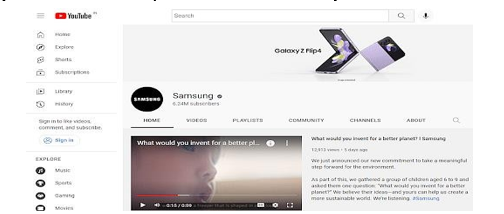
To connect with the various segments of the population their products target, Samsung has social profiles on all of the major social networks, including
- Facebook: 162M
- Twitter: 12.5M
- YouTube: 6.24M
- Instagram: 4.5M
Moreover, Samsung has several profiles on each platform. For instance, Instagram has Samsung, Samsung India, Samsung UK, Samsung UA, Samsung Mobile and more. The company adheres to the best digital marketing practices like SEO and quality content creation that solves customer problems.
2. Digital Marketing Campaigns of Samsung
Being a community-oriented brand that impacts audiences worldwide, Samsung introduces various marketing campaigns. The promising Samsung marketing strategy focuses on leveraging the power of exceptional marketing campaigns to promote its products and appeal to the audience.
Social media ads, sponsorships, and online advertising strengthened the brand. Some exceptional Samsung marketing campaigns are as follows:
- #You Make Campaigns: It brings up a global marketing platform for consumers to take the lead with device customization. It brings a better way of personalization via customized control enabled by Smart Things IoT solutions. The #You Make campaign offers continuous services and virtual benefits, encouraging customer participation by utilizing the best met averse platforms.
- Growing Up: Another commercial on YouTube that made people reconsider their options. The company directly targeted its main competitor–Apple, and the video took the internet by storm.
3. Marketing Mix of Samsung
Product, Price, Place, and Promotion–the 4Ps of the marketing mix constitute an integrated marketing model. Samsung’s marketing mix plan gives insights into the company’s success secret.
a. Product Mix
Delivering excellent results in recent years, Samsung products are well-known for their services and quick support. Samsung’s marketing mix in its product line is one of its major strong points. The products fall into the following categories:
- Mobile phones
- Tablets
- Televisions – LEDs, Plasma TV, LCDs, SMART TV, HDT
- Cameras
- Refrigerators
- Air Conditioners
- Washing Machine
- IT – Printers, laptops, and accessories
b. Price Mix
Price mix is one of the strongest points in the Samsung marketing strategy. It offers two pricing schemes to satisfy its clients. The corporation adopts a price skimming tactic whenever it releases a new smartphone with the latest technology. Moreover, it reduces the price of that product when the competitors launch identical products.
c. Promotion Mix
Samsung attracts customers via advertising while employing the best tactics to push products through sales promotions. The company employs several marketing vehicles both during the festive season and outside of it. It grants numerous discounts and incentives to business partners, encouraging them to sell Samsung products above the competition.
d. Place Mix
Samsung service dealers are responsible for corporate sales. Its selling point is its distribution. They distribute their goods via a single distribution business. They then distribute them to other locations.
E. SWOT Analysis
SWOT analysis is one of the best ways to dive deeper into the Samsung marketing technique. It provides insights into Samsung’s strengths, weaknesses, opportunities, and threats concerning its marketing competitiveness.
- Samsung’s Strengths
- It has held a strong position in the smartphone manufacturing industry for years. Climbing the ladder, Samsung ranks first on the world’s best smartphone manufacturers list.
- Significant investments in the innovative research and development sector have helped Samsung generate a diverse product offering compared to its competitors.
- Its transition to a customer-centric management system has brought about revolutionary changes.
- Its consistent efforts for sustainable development, such as the adoption of eco- packaging for TVs, give it the upper hand.
- Samsung leads the development of advanced technologies like AI, 5G, automotive and robotics.
- Lastly, it is rapidly expanding commercial marketing in India and China.
2. Samsung’s Weakness
- Despite expanding its operations in Asia, the company relies heavily on American markets.
- Samsung’s defective items, such as the Samsung Galaxy A20e and a malfunctioning foldable phone.
3. Samsung’s Opportunities
- Samsung can achieve tremendous development in the smartphone industry by setting the standard with innovative goods like foldable phones.
- As the world adopts 5G, Samsung has the know-how to capitalize on the opportunity.
- The company can hire exceptionally skilled professionals using its brand image.
4. Samsung’s Threats
- Samsung’s entanglement in controversies can jeopardize its business, such as the lawsuit filed by Apple for patent infringement.
- Xiaomi, Apple, and Huawei stand as major threats and technological competitors who can outsmart Samsung.
IV. ANALYSIS AND INTERPRETATION
Analysis and Interpretation refers to a systematic and critical examination of the financial statements. It not only establishes cause and effect relationship among the various items of the financial statements but also presents the financial data in a proper manner. The main purpose of Analysis and Interpretation is to present the financial data in such a manner that is easily understandable and self-explanatory. This not only helps the accounting users to assess the financial performance of the business over a period of time but also enables them in decision making and policy and financial designing process.
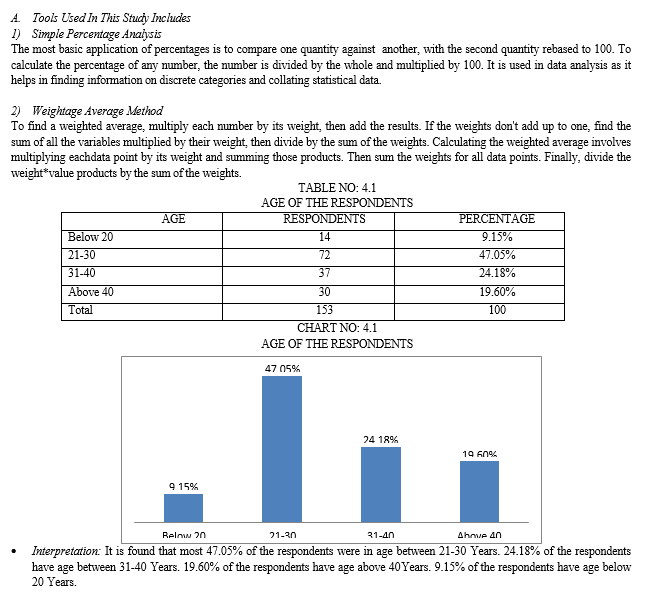
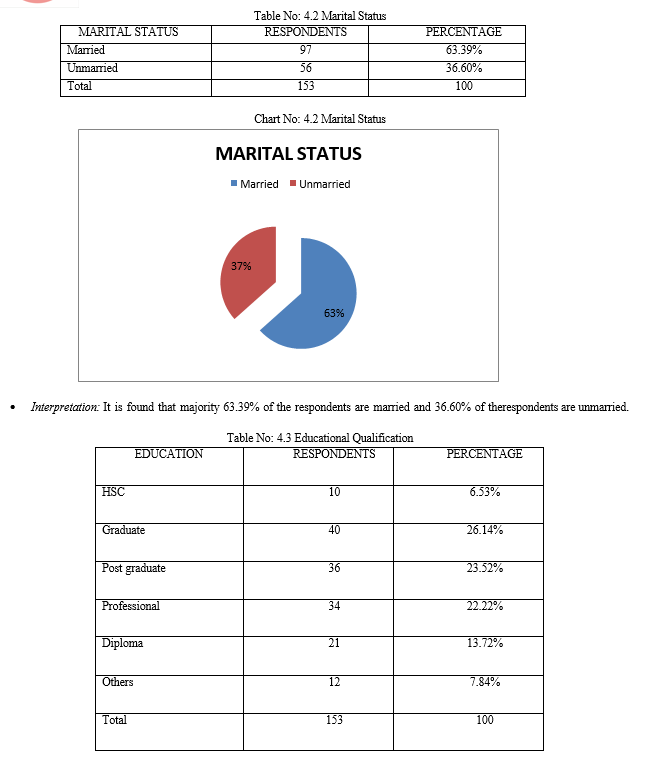
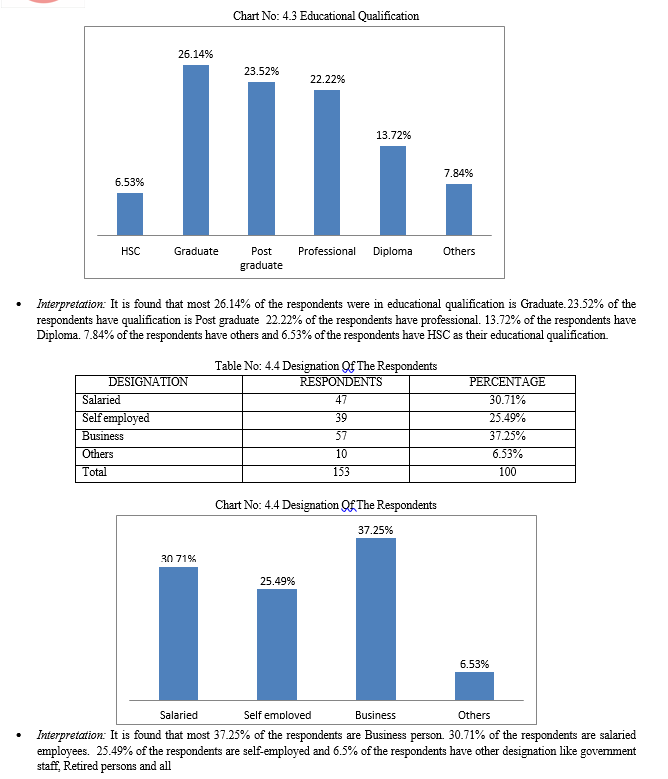
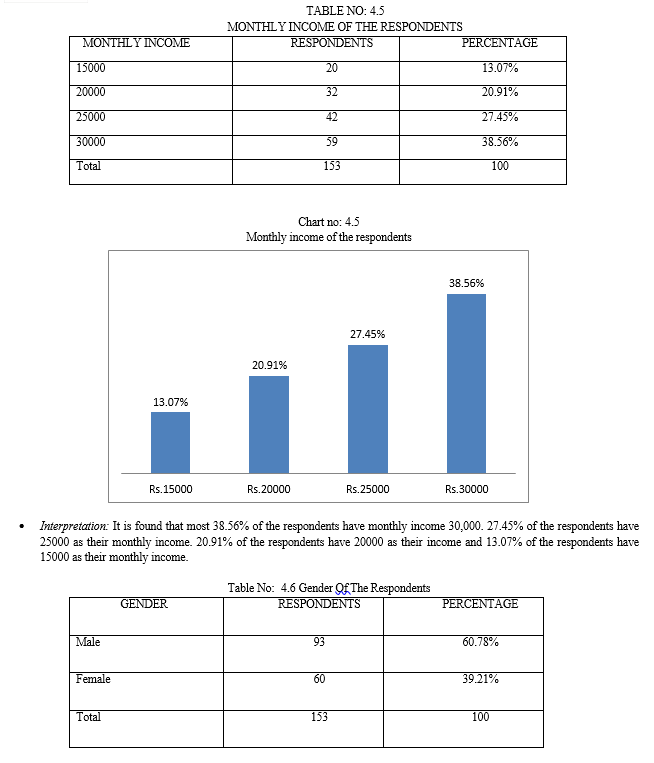
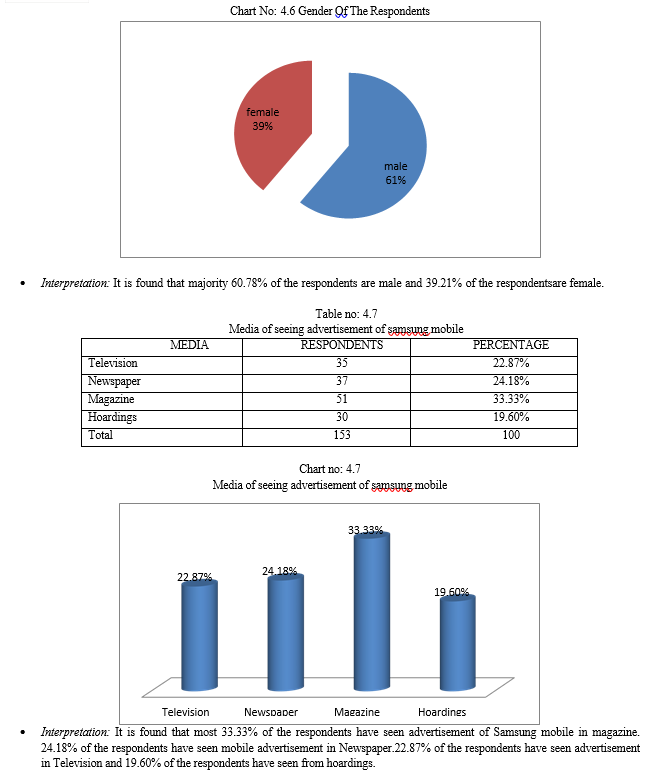
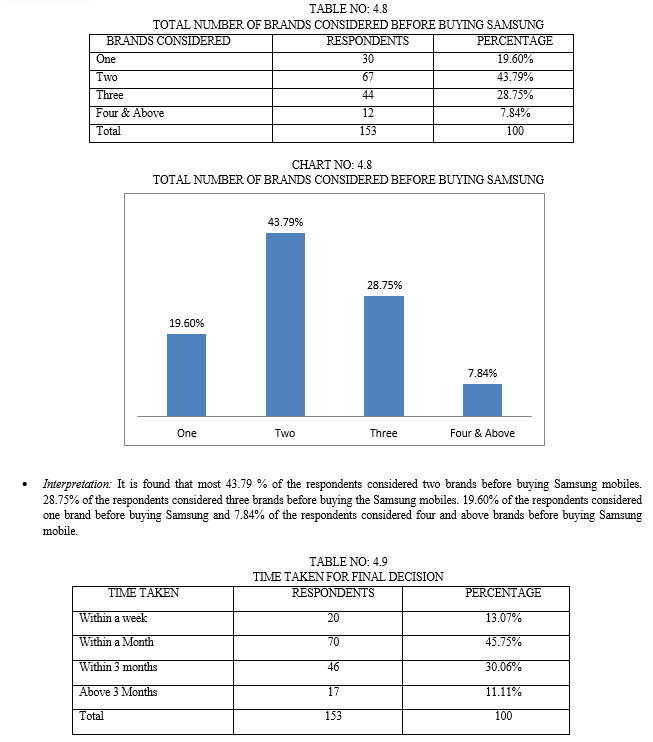

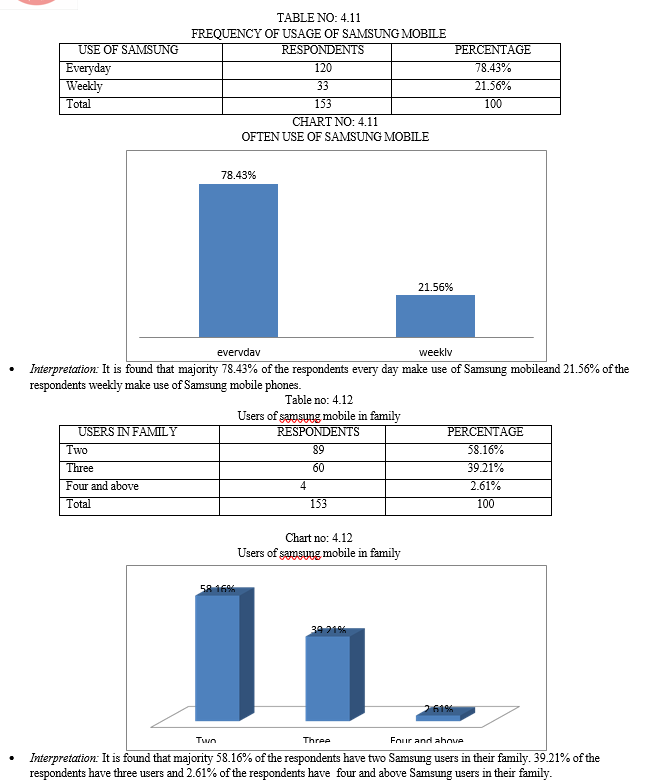
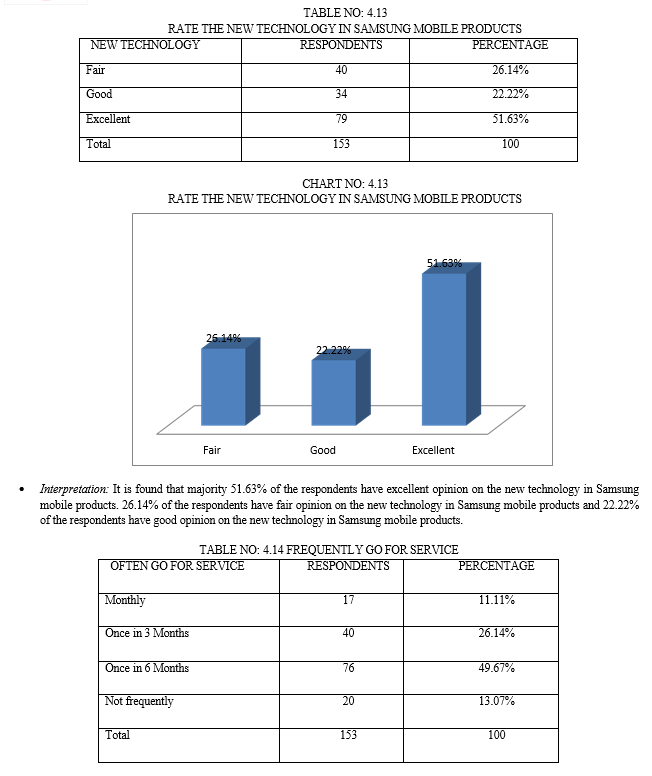
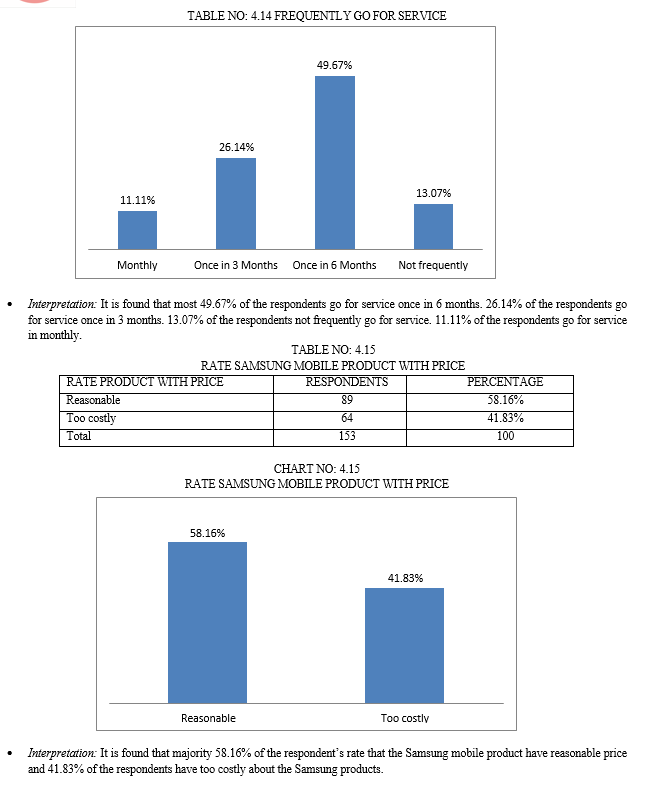
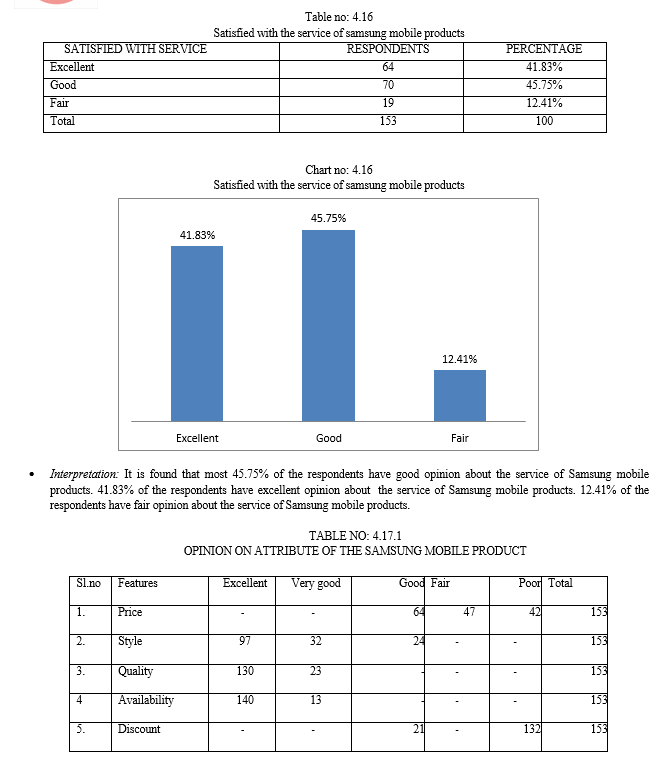
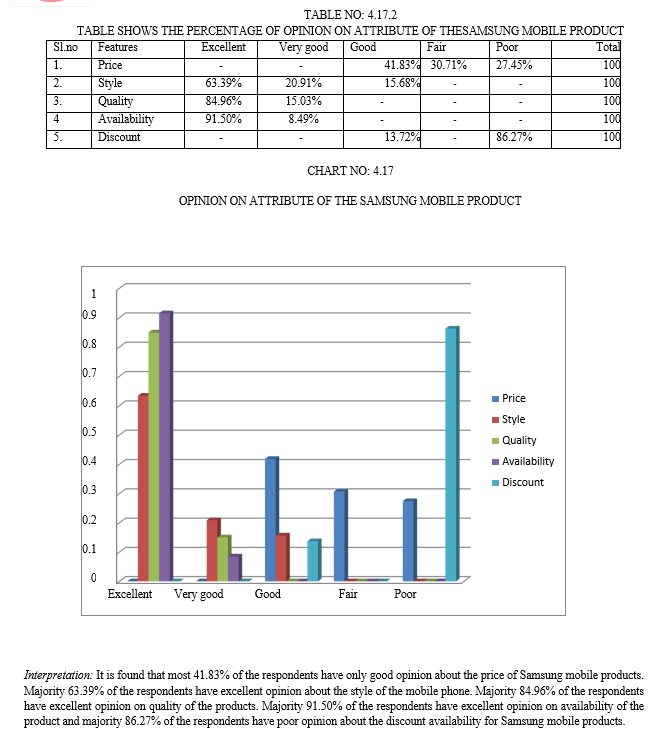
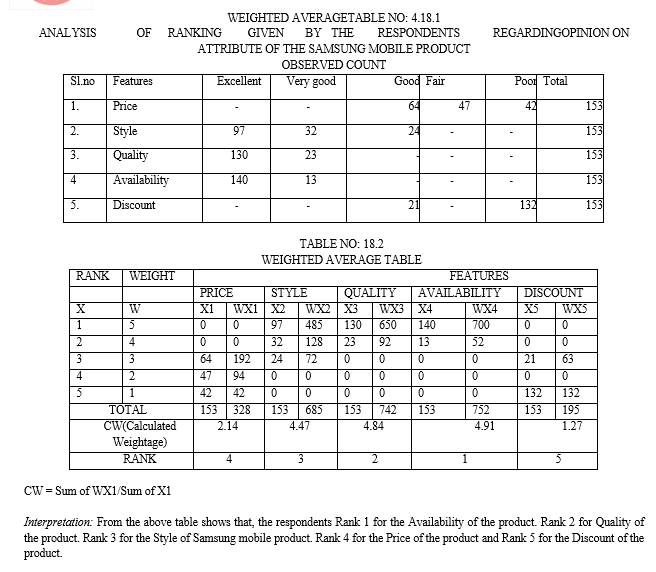
V. FINDINGS, SUGGESTIONS, CONCLUSION
A. Findings
The main motive of the study is to find out the customer opinion on the usage of Samsung Mobile Phones. The researcher has the aim to know about the major feature attract the customer most and the service quality of the mobile. This study helps to measure the overall satisfaction with the availability features of Samsung products by the customers. So for making findings the collected data should be analysed. For analysis the simple percentage method and weighted average methods are used in this study. The final chapter deals with the findings based on the customers responses.
- Percentage Analysis
a. Most 47.05% of the respondents have age between 21-30 Years old.
b. Majority 63.39% of the respondents are married
c. Most 26.14% of the respondents have educational qualification is Graduate.
d. Most 37.25% of the respondents are Business person.
e. Most 38.56% of the respondents have monthly income around 30,000.
f. Majority 60.78% of the respondents are male.
g. Most 33.33% of the respondents have seen advertisement of Samsung mobile in magazine.
h. Most 43.79 % of the respondents considered two brands before buying Samsung mobiles.
i. Most 45.75% of the respondents take final decision within a month.
j. Most 39.21% of the respondents have made the decision solely.
k. Most 78.43% of the respondents every day make use of Samsung mobile
l. Majority 58.16% of the respondents have two Samsung users in their family.
m. Majority 51.63% of the respondents have excellent opinion on the new technology in Samsung mobile products
n. Most 49.67% of the respondents go for service once in 6 months. 26.14% of the respondents go for service once in 3 months
o. Majority 58.16% of the respondents rate that the Samsung mobile product have reasonable price
p. Most 45.75% of the respondents have good opinion about the service of Samsung mobile products. 41.83% of the respondents have excellent opinion about the service of Samsung mobile products.
q. Majority 41.83% of the respondents have only good opinion about the price of Samsung mobile products.
r. Majority 63.39% of the respondents have excellent opinion about the style of the mobile phone.
s. Majority 84.96% of the respondents have excellent opinion on quality of the products.
t. Majority 91.50% of the respondents have excellent opinion on availability of the product
u. Majority 86.27% of the respondents have poor opinion about the discount availability for Samsung mobile products
2. Weighted Average
The respondents Rank 1 for the Availability of the product. Rank 2 for Quality of the product. Rank 3 for the Style of Samsung mobile product. Rank 4 for the Price of the product and Rank 5 for the Discount of the product.
B. Suggestions
- Table no: 4.17.1 Respondents suggest reducing the price in order to gain more customers.
- Table no: 4.17.1: Customers more attracted towards “quality” as the reason for changing the smart phones. Hence, it is recommended that the company should try to improve the quality in order to satisfy their customers.
- Table no: 4.17.1: Customers are dissatisfied with the discounts provided by the company. The respondents suggest providing any discounts in price or any other offers will be more satisfied by them.
- Table no: 4.7: With regard to advertisement of the Samsung smart phone is concerned, majority of the respondents are highly satisfied. Hence, it can be suggested that the company should maintain its advertisement in the same level or even more in order to maintain its customer.
C. Conclusion
During the evaluation of smart phones, it acts as a luxury product in due course of time it became the basic necessity of every human. A mobile hand held computer. New generation may be called as mobile phone generation. Mobile phones have become an inseparable part of human. Among the people SAMSUNG is the leading in the mobile industry. Among many of branded mobile phone were perfect SAMSUNG because of its quality and new innovation. And it is easy to browse the internet, best cost control, good battery life and better services. They are the market leaders. This study conducted from Coimbatore city, Samsung smart phones is a highly moving smart phones, when compared to other smart phone. The study about the various aspects of customer satisfaction on Samsung smart phones in Coimbatore city satisfied the following objectives i.e. handling convenience in Samsung smart phones and the quality of service provider in Samsung smart phones. The survey conducted from Coimbatore city helps to make identification over its strength and weakness of Samsung smart phone
VI. ANNEXURE
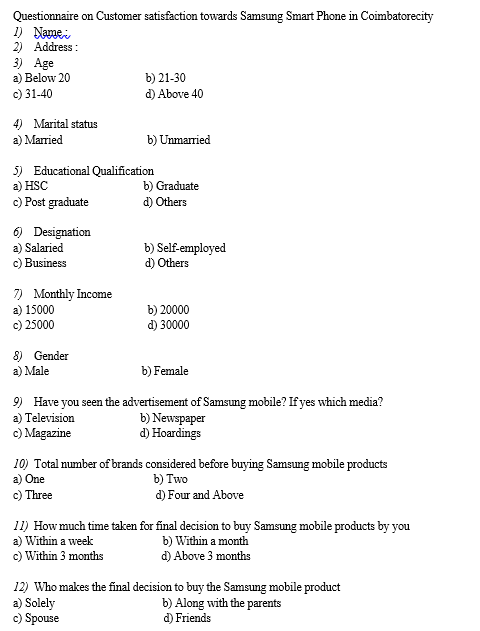
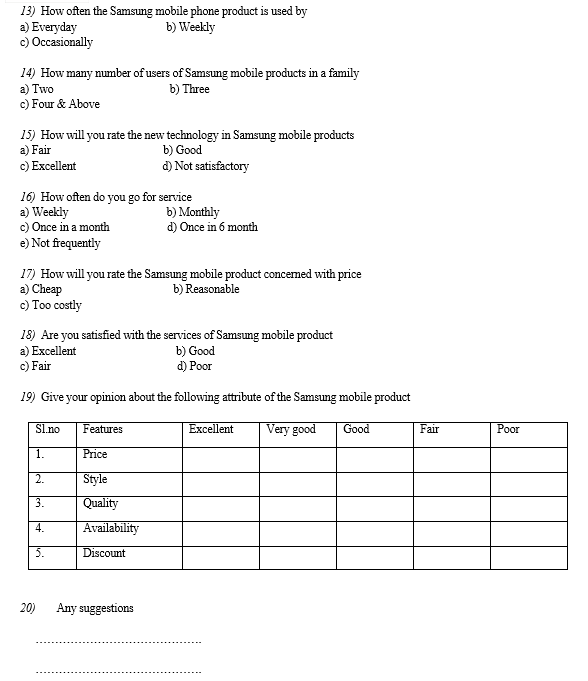
Conclusion
[1] www.samsungmobile.com [2] www.wikipedia.com [3] www.scribd.com [4] www.academiaedu.com [5] www.googlescholar.com [6] www.shodganga.com [7] www,linkedin.com [8] googlebooks.com [9] www.indianmarket.com [10] www.industryscenario.in [11] https://www.zdnet.com/article/chinas-smartphone-market [12] https://www.ama.org/AboutAMA/Pages/Definition-ofMarketing.aspx [13] http://erenkocyigit.com/marketing-scope-philosophical-foundations-needed- reforms [14] http://smartphonemarketavailability.com [15] http://indiansmartphonemarket.com
Copyright
Copyright © 2023 Rinaf Mohammed . This is an open access article distributed under the Creative Commons Attribution License, which permits unrestricted use, distribution, and reproduction in any medium, provided the original work is properly cited.

Download Paper
Paper Id : IJRASET52228
Publish Date : 2023-05-14
ISSN : 2321-9653
Publisher Name : IJRASET
DOI Link : Click Here
 Submit Paper Online
Submit Paper Online

